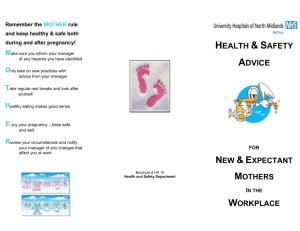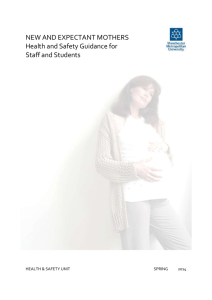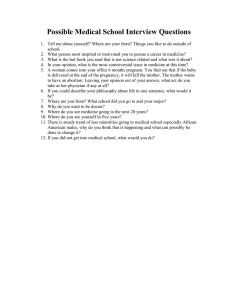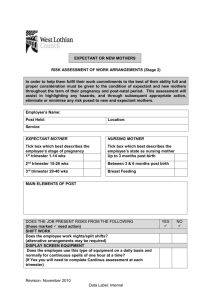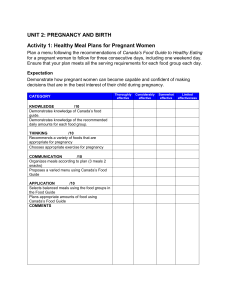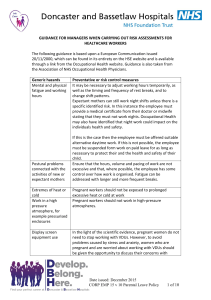Risk Assessment New and Expectant Mothers at Work
advertisement
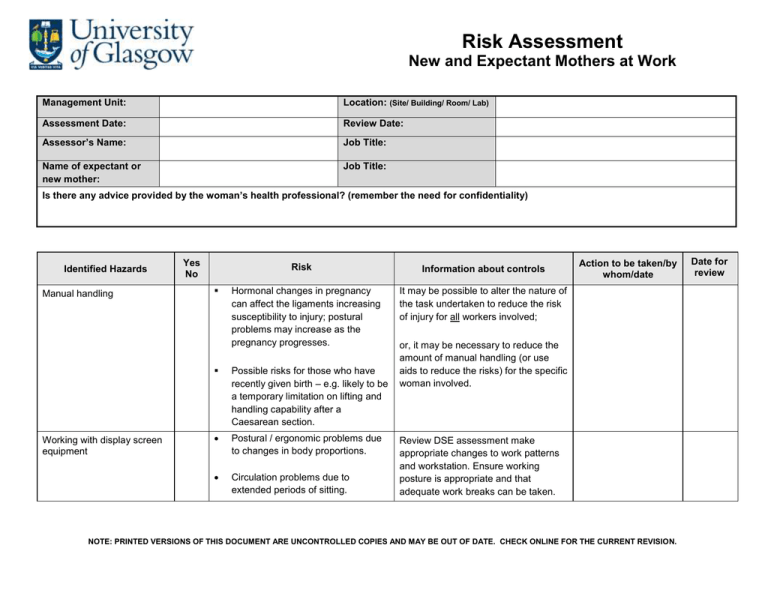
Risk Assessment New and Expectant Mothers at Work Management Unit: Location: (Site/ Building/ Room/ Lab) Assessment Date: Review Date: Assessor’s Name: Job Title: Name of expectant or new mother: Job Title: Is there any advice provided by the woman’s health professional? (remember the need for confidentiality) Identified Hazards Manual handling Working with display screen equipment Yes No Risk Hormonal changes in pregnancy can affect the ligaments increasing susceptibility to injury; postural problems may increase as the pregnancy progresses. Possible risks for those who have recently given birth – e.g. likely to be a temporary limitation on lifting and handling capability after a Caesarean section. Postural / ergonomic problems due to changes in body proportions. Circulation problems due to extended periods of sitting. Information about controls Action to be taken/by whom/date It may be possible to alter the nature of the task undertaken to reduce the risk of injury for all workers involved; or, it may be necessary to reduce the amount of manual handling (or use aids to reduce the risks) for the specific woman involved. Review DSE assessment make appropriate changes to work patterns and workstation. Ensure working posture is appropriate and that adequate work breaks can be taken. NOTE: PRINTED VERSIONS OF THIS DOCUMENT ARE UNCONTROLLED COPIES AND MAY BE OUT OF DATE. CHECK ONLINE FOR THE CURRENT REVISION. Date for review Identified Hazards Movements and postures Yes No Risk Information about controls Standing: Continuous standing during the working day may lead to dizziness, faintness, and fatigue. It can also contribute to an increased risk of premature childbirth and miscarriage. Sitting: Pregnancy-specific changes pose a relatively high risk of thrombosis or embolism, particularly with constant sitting. In the later stages of pregnancy, women are more likely to experience backache, which can be intensified by remaining in a specific position for a long period of time. Restricted space: Difficulties in working in tightly fitting work spaces or workstations during the later stages of pregnancy can lead to strain or sprain injury, also with impaired dexterity, agility, coordination, speed of movement, reach and balance. Also, associated increased risk of accidents Work and personal protective equipment Control hours, volume and pacing of work. Adjust how work is organised or change type of work if necessary. Ensure seating is available where appropriate, and take longer or more frequent rest breaks to avoid or reduce fatigue. Adjusting workstations or work procedures where this will minimise postural problems and risk of accidents. Review situation as pregnancy progresses. Wherever possible, the risk should be avoided by adaptations or substitution, e.g. providing suitable alternative equipment to allow the work to be conducted safety and without risk to health. 2 Action to be taken/by whom/date Date for review Identified Hazards Working alone Yes No Risk Information about controls Pregnant women are more likely to need urgent medical attention Review and revise access to communications with others. Consider levels of supervision involved Ensure that emergency procedures take into account the needs of new and expectant mothers. Work at height It is hazardous for pregnant women to work at heights, for example ladders, platforms. Working at height should be avoided where possible. A risk assessment should consider any additional risks due to work at height (e.g. working on ladders). Chickenpox / shingles Pregnant women who have been in contact with chickenpox or shingles and have no history of chickenpox must contact their GP promptly for advice. Work related violence 3 Change the design of the job i.e., avoiding lone working, reducing use of cash, maintaining contact with workers away from the base. Improve the design or layout of the workplace Provide adequate training and information. Action to be taken/by whom/date Date for review Identified Hazards Mental and physical fatigue and working hours Yes No Risk Information about controls Long working hours, shift work and night work can have a significant effect on the health of new and expectant mothers, and on breastfeeding. Because they suffer from increasing tiredness, some pregnant and breastfeeding women may not be able to work irregular or late shifts or night work, or overtime. Working time arrangements (including provisions for rest breaks, their frequency and timing) may affect the health of the pregnant woman and her unborn child, recovery after childbirth, or ability to breastfeed, and may increase the risks of stress and stress related ill health. Due to changes in blood pressure which may occur during and after pregnancy and childbirth, normal patterns of breaks from work may not be adequate for new or expectant mothers Stress Stress is associated in some studies with increased incidence of miscarriage and pregnancy loss, and also with impaired ability to breastfeed. Stress also can contribute to anxiety and depression. Adjust working hours temporarily, as well as other working conditions, including the timing and frequency of rest breaks. The need for physical rest may increase. As appropriate, allow access to somewhere to sit or lie down comfortably in private and without disturbance. Adjust working conditions and hours Ensure that necessary understanding, support and recognition is available (consider the return to work). Take account of known organisational stress factors (shift patterns, job insecurity, workloads etc) and the particular medical and personal factors affecting the individual. 4 Action to be taken/by whom/date Date for review Identified Hazards Chemical agents Yes No Risk Information about controls The risks will depend on the way in which the substance is being used as well as on its hazardous properties. Carry out a COSHH assessment for women who are pregnant, have recently given birth or who are breastfeeding. Absorption through the skin can result from localised contamination – e.g. a splash on skin or clothing, or in certain cases from exposure to high atmospheric concentrations of vapour Prevention of exposure is the top priority. Substitution of harmful agents if possible; if not then control by combination of technical measures, Good Laboratory Practice, and the use of Personal Protective Equipment (the latter only as a last resort and in combination with the other control measures). The worker may have to be assigned other duties away from the source of potential exposure for the duration of the pregnancy and nursing period. Prevention of exposure is the top priority. Substitution of harmful agents if possible; if not then control by combination of technical measures, Good Laboratory Practice, and the use of Personal Protective Equipment (the latter only as a last resort and in combination with the other control measures). Carcinogens, mutagens and teratogens. The worker may have to be assigned other duties away from the source of potential exposure for the duration of the pregnancy and nursing period. 5 Action to be taken/by whom/date Date for review Identified Hazards Infectious Diseases Biological agents of hazard groups 2, 3 and 4 e.g. Brucella. Chlamydia,TB. Herpes simplex. Hepatitis virus. HIV. Mumps / measles Parvovirus. Rubella. Ionising and Non Ionising radiation Vibration Noise Yes No Risk Information about controls Following infection with these agents there is potential for abortion or physical and neurological damage to the unborn child. Carry out a COSHH assessment for women who are pregnant, have recently given birth or who are breastfeeding. For most workers, the risk of infection is not higher at work than from elsewhere, but in certain occupations exposure to infections is more likely, for example laboratory work, health care, looking after animals (farms and laboratories) or dealing with animal products (e.g. meat processing). Control measures may include physical containment, hygiene measures, and using vaccines if exposure justifies this. Also, elevated risks if in contact with sewage and contaminated water (at the University or on field trips). Significant exposure can harm the foetus (either through external exposure or by breathing in/ ingesting radioactive contamination) and there radioactive liquids or dusts can cause exposure of the child, particularly through contamination of the mother’s skin. Regular exposure to shocks, low frequency vibration (e.g. driving or riding in off-road vehicles) or excessive movement may increase the risk of miscarriage. (there is no particular risk to breastfeeding workers) Prolonged exposure to loud noise may lead to increased blood pressure and tiredness. 6 If there is a known high risk of exposure to a highly infectious agent, then it will be appropriate for the pregnant worker to avoid exposure altogether. Work procedures should be designed to keep exposure below the statutory dose limit for pregnant women. A specific risk assessment is required. Nursing mothers should not work where the risk of contamination is likely. Avoid work likely to involve uncomfortable whole body vibration, especially at low frequencies or where the abdomen is exposed to shocks or jolts. Conform to the Noise at Work Regulations (consult with the SEPS if in doubt). Action to be taken/by whom/date Date for review Identified Hazards Yes No Risk Information about controls Action to be taken/by whom/date Date for review If you identify any further hazards or if any of the following apply to the work carried out please contact your departmental safety adviser or SEPS: e.g. Travelling either inside or outside workplace, shocks and vibration, electromagnetic radiation, confined spaces, mercury and mercury derivatives, lead and lead derivatives, carbon monoxide. Further hazards should be detailed below as applicable: Hazard Risk Controls Review Date Other aspects of the pregnancy which may be affected by work e.g. exposure to smells affecting nausea, breast discomfort due to increased size and sensitivity (The impact may vary during the course of the pregnancy and you will want to keep their effects under review) Aspect/work issue Risk Yes / No Controls Review Date The persons below should sign to show that the assessment is a correct and reasonable reflection of the hazards and of the control measures and actions required. New/ Expectant Mother’s (please print): New/Expectant Mother’s signature: Date: Health & Safety Coordinator’s (please print): Health & Safety Coordinator’s signature: Date: Line Manager’s (please print): Line Managers signature: Date: Please note. Where a significant risk still remains, i.e. the task cannot be avoided/ carried out by someone else or further controls cannot be implemented, you must liaise with local Safety Coordinator, Occupational Health, SEPS and your HR section. This risk assessment should be held in a confidential personnel file. The employee should keep a copy for their own use and reference. 7
